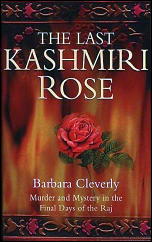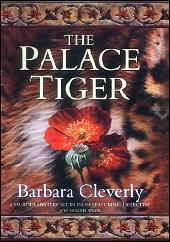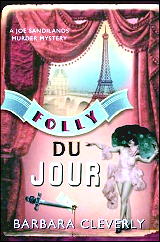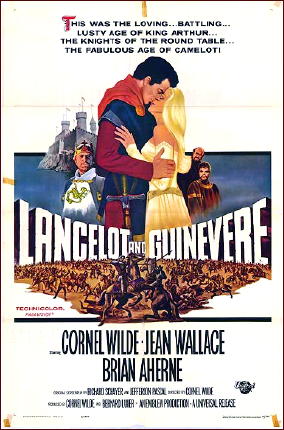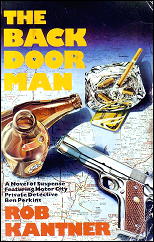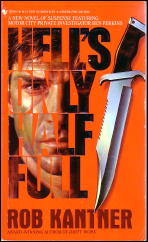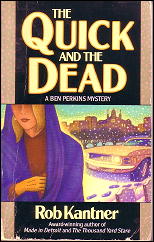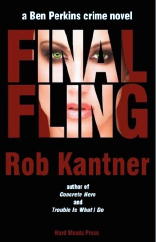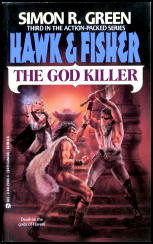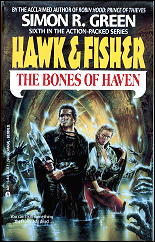June 2010
Monthly Archive
Tue 22 Jun 2010
IT IS PURELY MY OPINION
Reviews by L. J. Roberts
BARBARA CLEVERLY – Strange Images of Death. Constable, UK, hardcover, March 2010. Soho Constable, US, hardcover, April 2010.
Genre: Police procedural. Leading character: Commander Joe Sandilands, 8th in series. Setting: France; 1926.
First Sentence: He studied her sleeping face for the last time.
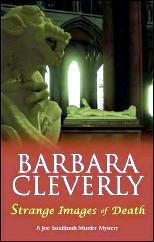
Scotland Yard Commander Joe Sandilands is taking Dorcas, his friend’s 14-year-old daughter, to meet her artist father at an old castle in Provence. On the way, she asks Joe to find the mother who abandoned her when she was 2 years old.
Upon arrival, there is a second mystery to solve. It begins with the destruction of a tomb figure, escalates to the death of a rabbit and culminates in the murder of a beautiful woman. Forced to work with French Commissaire Francis Jacquemin, known for arresting first, then forcing confessions, Joe must ensure he catches the proper killer and prevents any more deaths.
Characters. It is they who bring a story to life and Cleverly’s characters do not disappoint. They are fully developed with their backgrounds established and their personalities distinct. We not only learn about Joe, for those who’ve not read previous books in the series, but are told of his appearance in an unforced manner.
A predominant young character can be awkward, but not here. Dorcas, his 14 year old “niece” is someone who holds her own. She is someone I want to see remain part of the series, if not in every book but certainly in the future. There was a character I felt wasn’t as strong an element as I thought might be, but I was okay with that.
Cleverly is a very visual writer, whether in panorama or in detail. You have a real sense of their surroundings at all times. I appreciate dialogue that has a natural ear and flow with a touch of humor, and she satisfies on all aspects.
This book’s opening hook is very strong; suspenseful, dramatic and ultimately brutal without the reader having to witness the act. It is also, we soon learn, the first of many excellent twists within the plot, this first so subtle you don’t realize it until later.
Cleverly skillfully interweaves interesting historical information into the story as well as providing an adept explanation of French and English police ranks and an amazing assessment of Van Gogh’s self portrait.
These are only a few examples of the deftness with which Ms. Cleverly writes, with none of these causing a break in the flow of the story. Add to that an emotional secondary mystery, and just the right touch of suspense and you have a well thought out and well executed traditional mystery.
Each year I plan for the release of the newest Sandilands book and order it as soon as it is available. If you’ve not read them, do start at the beginning of the series and set aside uninterrupted time to enjoy each one. I know why they rank so high on my “must read” list; they are excellent.
Rating: Excellent.
The Detective Joe Sandilands series —
1. The Last Kashmiri Rose (2001)
2. Ragtime In Simla (2002)
3. The Damascened Blade (2003)
4. The Palace Tiger (2004)
5. The Bee’s Kiss (2005)
6. Tug of War (2006)
7. Folly Du Jour (2007)
8. Strange Images of Death (2010)
Barbara Cleverly has also written three books about aspiring archaeologist Leatitia Talbot, a series that also takes place in the late 1920s and various exotic places around the world.
Tue 22 Jun 2010
FIRST YOU READ, THEN YOU WRITE
by Francis M. Nevins
Of all the authors who in the years after World War II moved mystery fiction “from the detective story to the crime novel,” perhaps the most influential American woman was Patricia Highsmith (1921-1995).
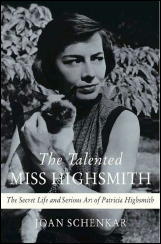
Certainly she’s the only one to have received so much critical attention after her death: first Andrew Wilson’s biography in 2003, more recently Joan Schenkar’s The Talented Miss Highsmith, which isn’t a conventional biography but more an exploration of Highsmith’s obsession-torn mind and emotions and how they spilled over into novels like Strangers on a Train and The Talented Mr. Ripley.
If you think Cornell Woolrich was something of a psychopath and a creep, you don’t know the meaning of those words till you’ve encountered Highsmith.
Both, of course, were homosexual. I gather from Schenkar’s book that Highsmith, who was born in Texas and came of age in the feverish New York of the World War II years and went through lovers with the fury of a Texas twister, was never terribly comfortable with being a lesbian.
Woolrich was perhaps the most deeply closeted, self-hating homosexual male author that ever lived. Both wound up worth several million but often acted as if they were penniless. Both lived mainly on booze, cigarettes and coffee, with peanut butter added to the diet in Highsmith’s case.
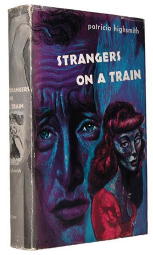
Both bequeathed their copyrights and other property to institutions, not human beings. Woolrich left an autobiographical manuscript (Blues of a Lifetime) which is full of obvious fiction; Highsmith left 8000 pages of notebooks which, as Shenkar demonstrates, are also pockmarked with falsifications.
But there were notable differences too. Just to mention one, Highsmith was fixated on possessions, keeping everything (except any paper trail leading back to the seven years she had spent in her twenties writing scripts for comic books like Spy Smasher and Jap Buster Johnson), while Woolrich kept nothing, not even copies of his novels and stories.
It’s most unlikely that the two ever met. Woolrich read very little crime fiction but appeared regularly in Ellery Queen’s Mystery Magazine in the Fifties and Sixties and may have read Highsmith’s EQMM stories.
We know she read the magazine steadily and, in her book Plotting and Writing Suspense Fiction, devoted almost a full page to Woolrich’s “Murder After Death” (EQMM, December 1964).
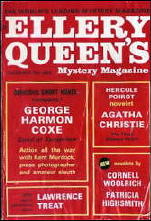
Why did she single out this rarely reprinted and never collected tale? Perhaps she saw something akin to her own evil protagonists in Georg Mohler, a loser at the game of love who turns to crime for emotional revenge.
When the wealthy and lovely Delphine rejects him for law student Reed Holcomb and then dies a sudden but natural death, Mohler concocts a laughably dumb plot to sneak into the funeral parlor, inject poison into her body and frame Holcomb for murder.
Woolrich’s detail work is sloppy and implausible and his climactic twist, like those in several of his earlier stories, comes straight out of James M. Cain’s The Postman Always Rings Twice. But the scene where Mohler hides in the funeral home and posthumously poisons his lover’s corpse is a gem of poetic horror.
If any single element in the tale deserved Highsmith’s attention it was this one. In fact she spent most of the page summarizing the plot, calling it a “quite well-done gimmick story” with “an elaborate but quite entertaining and believable scaffolding….” Go figure.
It was a gimmick—the two men in Strangers on a Train (1950) agreeing (or did they?) to exchange murders — that first made crime fiction readers (not to mention Alfred Hitchcock) take notice of the not yet 30-year-old Highsmith.
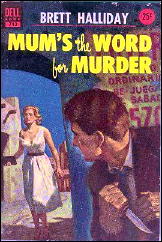
Later authors including Nicholas Blake and Fredric Brown worked their own variations on the theme. But who remembers its first appearance in the genre?
Mum’s the Word for Murder (1938) uses very much the same gimmick, although here it involves three murders, not two, and is saved till the solution rather than employed as a springboard.
The byline on this long-forgotten book was Asa Baker but the author’s real name was Davis Dresser and his best-known pseudonym was Brett Halliday, which he used for the all but endless adventures of Miami PI Michael Shayne, beginning in 1939, a year after Mum’s the Word came out.
As chance would have it, much of both novels is set in Texas, where both Dresser and Highsmith spent several of their formative years.
Mon 21 Jun 2010
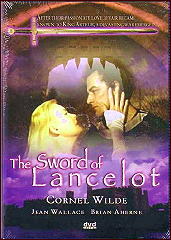
THE SWORD OF LANCELOT. Universal Pictures, 1963. Released originally in the UK as Lancelot and Guinevere. Cornel Wilde (Lancelot), Jean Wallace (Guinevere), Brian Aherne (King Arthur), George Baker, Archie Duncan, Michael Meacham, Mark Dignam (Merlin). Director & co-screenwriter: Cornel Wilde.
Everyone reading this knows the story, or you should, so I won’t take the time or space to go into details. But the details do change every time the story is filmed — and how many times has it been? — which is why every time it’s filmed, it’s worth seeing again.
There must be something in the story, the ill-fated love triangle between Arthur, Guinevere and Lancelot, that keeps it fresh and entertaining, no matter how times you see it.
I do have a couple of comments, though, and as I keep typing, the couple may turn into a few. The first, though, are the ages of the performers. Brian Aherne was 61 and close to the end of his acting career. Cornel Wilde was 48, and Jean Wallace, to whom he was married at the time, was 40.
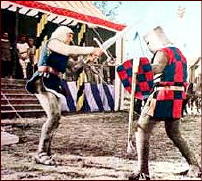
They were not youngsters, but even if you were to think them too old — by say 20 years — with their general enthusiasm and zeal for their roles, they can make you believe that they are younger, or very nearly so.
By all appearances, Cornell Wilde was working with a relatively low budget. This is not a lavish, MGM-style motion picture. But I think the non-majestic if not homely surroundings for the interior of Camelot are more likely to have been the case at the time, if Camelot every really existed, than the splendiforous, wonderfully marvelous settings you may see in other movie versions of the tale, if not most of them.
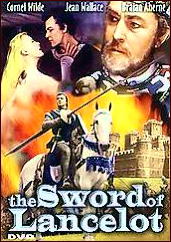
The movie is in color, which is definitely a plus. And the battles on horseback and on foot, with lances, spears, axes, maces and any other fierce-looking weapons the combatants could get their hands on are equally authentic looking.
Not to mention gruesome. One gets the feeling at times that this is the way battles really looked, with swords sticking out of endless bodies on the ground, with the constant danger of being trampled underfoot, if they were not already dead.
Merlin plays a relatively small role, I am disappointed to say, but Arthur seems really delighted to have Guinevere brought to him by Lancelot, and I felt badly for him when things do not work out the way he anticipates. Even worse, his final fate is dealt with off-screen and well after the fact, and I was disappointed in that as well. He deserved better.
Mon 21 Jun 2010
IT’S ABOUT CRIME
by Marvin Lachman
B. A. PIKE – Campion’s Career: A Study of the Novels of Margery Allingham. Popular Press, hardcover/trade paperback, 1987.
— Reprinted from
The MYSTERY FANcier,
Vol. 10, No. 2, Spring 1988.
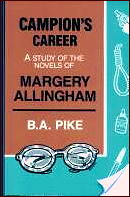
While primarily of interest to a limited audience, B(arry) A. Pike’s Campion’s Career is a loving evocation of the creation of one of the great writers of the detective story’s golden age.
Pike conveys the wit and wisdom of Allingham and the complex character she invented, deftly showing Camplon’s evolution from a silly ass to a wise and avuncular detective.
I recommend it without reservation to all who have read Allingham. I suspect that those who haven’t will get more by reading the original first, then reading Pike on Allingham.
Editorial Comments: It is may not be complete, but Google does have the book online, most if not all. You can check it out here.
This is the fourth in a series of reviews in which Marv covered reference works published in 1987, books about the field of mystery and crime fiction. Preceding this one was An Introduction to the Detective Story, by LeRoy Lad Panek. You can find it here.
Previously on this blog:
Call for Campion Complete, by Mike Nevins (the Campion short stories)
Tether’s End (reviewed by Tina Karelson)
Death of a Ghost (a 1001 Midnights review by Thomas Baird)
Mr Campion and Others (reviewed by Mike Tooney)
Dancers in Mourning (reviewed by Steve Lewis)
Mon 21 Jun 2010
Posted by Steve under
Reviews[4] Comments
Reviewed by DAVID L. VINEYARD:
PETER DICKINSON – A Summer in the Twenties. Pantheon, US, hardcover, 1987. Hodder & Stoughton, UK, hardcover, 1981.
“Everything’s changing so fast,” she said. “Isn’t it stunning to wake up every morning and feel the whole world is brand new again, a present waiting for you to unwrap it?”
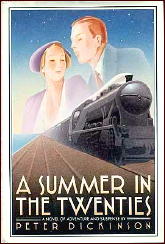
The year is 1926, and the Twenties are Roaring with flappers and social conscience and colliding with the death of the Victorian era and Red scares about rising Bolshevism. That’s the background for Peter Dickinson’s A Summer in the Twenties.
This one is more a thriller than a detective story though Dickinson was one of the bright lights of the late flowering of the fair play detective story. He and Robert Barnard almost single-handedly revived the genre injecting humor and style as well as real insights into character and action and in many ways extending the traditions begun by Agatha Christie, Dorothy L. Sayers, and Michael Innes, even as P.D. James and Ruth Rendell were taking the genre in their own directions.
Dickinson’s best books were those featuring Superintendent Jimmy Pibble, and his Poison Oracle — in which the detection is done by a chimp who has been taught to communicate in a private zoo in the curious palace of a desert sheikdom — was chosen by H.R.F. Keating for his Crime and Mystery Stories The 100 Best Books (reviewed by Marv Lachman here ).
Thomas (Tom) Hankey is the hero of this one, the son of Lt. General Lord Milford, and a product of the privilege and wealth of the upper classes at a time when that meant more than money. At the novel’s start he is in the South of France pursuing the beautiful Judy Tarrant, another product of the same class.
But this idyll is cut short when Tom is summoned home by his father. A crisis is brewing in England, one that borders on revolution — the General Strike of 1926.
For those unfamiliar with the General Strike, it was an attempt by the British working class to shut down transportation and other industry in England to show both their importance to the country’s economy and protest social injustice, triggered by a lockout of coal miners. Instead it inspired paranoia in the upper and middle classes and the government, with memories of the recent Russian Revolution still fresh and the Tory government anxious to break the back of the Trades Unions.
While there were certainly some radicals on the left with visions of a revolution, that was far from the aims of the mass of strikers — but in this case appearance trumped reality. It became a defining moment in the class war in England and inspired the plots of many a thriller in the Sydney Horler and Sapper class. Dennis Wheatley’s first Gregory Sallust novel Black August was a Wellsian variation inspired by the General Strike.
And true to the spirit that would carry England through the Blitz, the upper and upper middle class rallied, manning the vital jobs of the working class and keeping the country going. Whatever your politics, it was a splendid effort mindful of WW II when even the then Princess Elizabeth was in uniform driving a staff car.
That’s why Tom’s father has called him home, to train as a volunteer engineer on the railway:
“Last year the Trades Unions got together and passed a resolution that if the miners were locked out the railways wouldn’t move any coal. I think they’ll stick to that — in fact I think they’ll go a good deal further, and there’ll be a General Strike and nothing will move at all … if we let the unions shut the country down and keep it shut down for a month we’re finished.”
His father has more sympathy for the miners than the owners, but the General Strike is anathema to him.
Tom is quickly dispatched to the slums of Hull, a mining town unlike anything in his life experience. There his wish to do his duty clashes with his innate sympathy for the workers and his sense of decency and fair play. Confronted by bullies and violence on both sides, gangs of hooded men with guns, he finds merely doing the right thing to be a challenge, and his feelings for Judy Tarrant are soon tested when he meets fiery Kate Barnes and a passionate agitator.
What makes reading Dickinson a pleasure is that the characters are well drawn and above all human. They make mistakes, have prejudices on both sides of the question, and manage to change, grow, and rise to the occasion as needed. Tom, Judy, and Kate all grow. He is also the brightest of writers, capable of real humor and rare intelligence.
Though there is little mystery element there is a good deal of action some railway lore and the growth of the main characters, especially Tom …
He was conscious that on the whole he had done right, but that all this was really through no virtue of his own … however blunderingly he had been doing things which later he would remember without a sour taste in the mouth … and certainly in no mood to believe that he had by more than a hairsbreadth diminished the ignorance and intransigence of either of the two forces he had been caught between.
This being Dickinson there is a killer and a mystery resolved, though a minor one, but as a portrait of a unique time and a picture of good people trying to resolve the differences that divide them, coming together for a common good, and facing the very real class divisions that separate them A Summer in the Twenties is a solid smart read.
If you don’t know Dickinson, he is well worth meeting. He took up writing at age forty after seventeen years as an editor at Punch. He was successful both as a children’s author and a mystery writer, winning a Gold Dagger from the Crime Writer’s and the Carnegie Medal for his children’s books, and his books, including King and Joker, The Lively Dead, One Foot in the Grave, Walking Dead, The Lizard in the Cup, and Skin Deep are all good examples of his many virtues.
Previously reviewed on this blog:
The Lively Dead (by Steve Lewis)
Mon 21 Jun 2010
REVIEWED BY BARRY GARDNER:
ROB KANTNER – The Red, White, and Blues. Harper, paperback original, 1993. Ben Perkins #8.
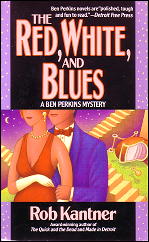
As I’ve said before, I don’t understand why Kantner’s stories of the Detroit PI, Ben Perkins, haven’t made it into hard covers. Perkins, a cigar-smoking ex-union enforcer who is now a part-time PI, part-time maintenance manager for an apartment complex, is no threat to the memory of Marlowe or Archer, but there are certainly those around who are less so.
Ben is trying to adjust to being a father, and to reinvent his relationship with the child’s mother, a lawyer who was once his lover and is still his occasional employer. Now she wants him to look into the disappearance of a child from one of Detroit’s major hospitals.
The problems from Ben’s point of view are two: it happened a year ago, and the mother is a thoroughly disreputable sort of person whom he neither likes or believes. He agrees to look into it, though he warns his ex-lover not to expect a happy ending.
He meets with deception or indifference everywhere he looks, but gradually accumulates enough facts to make him believe that something shady is going on. He’s “assisted” in his investigation by a recovering alcoholic from his apartment complex, a lady who presents him with a few problems on her own.
I like the way Kantner writes, and I like the character he’s created in Perkins. His knightly armor is far from unblemished, and the streets he walks are plenty mean enough. I think Kantner does as good a job as anyone when it comes to writing about Detroit.
The first person narrative is straightforward and effective, and Kantner has an ear for dialogue and a deft hand at characterization. The plots are the weak link in the series. They tend to degenerate into unlikely cowboy action, and this one is no different. With that caveat, I enjoyed it.
— Reprinted from Ah, Sweet Mysteries #10, November 1993.
The Ben Perkins Series —
* The Back Door Man (paperback, 1986)
* The Harder They Hit (paperback, 1987)
* Dirty Work (paperback, 1988)
* Hell’s Only Half Full (paperback, 1989)
* Made in Detroit (paperback, 1990)
* The Thousand Yard Stare (paperback, 1991)
* The Quick and the Dead (paperback, 1992)
* The Red, White and Blues (paperback, 1993)
* Concrete Hero (paperback, 1994)
* Trouble Is What I Do (hardcover, collection, 2005)
* Final Fling (hardcover, 2008)
Sun 20 Jun 2010
Posted by Steve under
Reviews[4] Comments
A REVIEW BY MARYELL CLEARY:
SARA PARETSKY – Deadlock. The Dial Press, hardcover, 1984. Paperback reprints include: Ballantine, 1984; Dell, 1992.
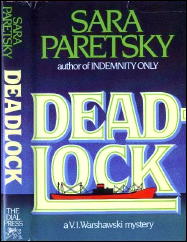
I am not a private eye fan, but even so, I like V.I. Warshawski. I like her loyalty to her cousin, ex-hockey player Boom Boom Warshawski, which leads her to investigate his death in spite of there being no one to pay her.
I like her tenacity, which keeps her going even after she recognizes that she is in danger. I like her intelligence, which enables her to master a field she knows nothing about and find vital clues.
As usual with P.I. novels, I’m sorry that there are so many deaths, especially those of innocent persons. But I’m happy to be introduced into Vic’s world: her friends, old and new, and her Chicago, a Chicago I never knew in 25 years of living there.
This is the Chicago of the city dweller, not the suburbanite; the Chicago of the long-time ethnic groups; the Chicago that is a Great Lakes port and headquarters of a substantial shipping industry. Boom Boom apparently falls to his death from a slippery pier, but V.I. discovers that he has been checking into the financial affairs of the grain company he’s working for.
Her investigation takes her to the Port of Chicago, to a large grain freighter, to the locks on the Soo, to elegant homes in Lake Bluff and a condo on Astor Place. I found out more about the business of shipping than I really wanted to know, but it was in a good cause — an interesting story and a fascinating wrap-up, with a P.I. I will read about again.
– Reprinted from The Poisoned Pen, Vol. 6, No. 4, Fall 1986.
Editorial Comments: I reviewed Deadlock back here a few months ago. I reported on the book at hand, but I think Maryell does a better job here in explaining V. I. Warshawki’s overall appeal, and why she’s been a best-selling character ever since her first appearance, which was Indemnity Only in 1982. Deadlock was her second.
Sun 20 Jun 2010
A REVIEW BY JIM WIDNER:
JOHN DUNNING – Two O’Clock, Eastern Wartime. Scribner, hardcover, 2001. Paperback reprint: Pocket, 2002.
In John Dunning’s 2001 thriller, Two O’Clock, Eastern Wartime, one of the characters says of radio:
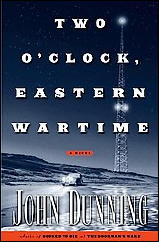
“And listen, the best that radio can do hasn’t even begun yet. Think of it in the Darwinian sense. Radio crawled out of the sea in nineteen twenty, and all this time we’ve been struggling to breathe air, not water. We haven’t even gotten our legs yet but maybe it’s time we at least begin to struggle to stand.”
Radio — dramatic radio — in a sense is one of the characters in the book. One of the main characters, Jordan Ten Eyck, is a writer who discovers the power of dramatic radio writing while he finds himself in the midst of a cracker of a thriller involving Nazi spies, murder and mystery surrounding a fledgling radio station, WHAR, in fictional Regina Beach, New Jersey. The time is 1942.
Dunning, as most old time radio fans know, is no stranger to radio or old-time radio. He is the author of two encyclopedias of the Golden Age of Radio: Tune in Yesterday and On the Air: The Encyclopedia of Old Time Radio.
He also was the host of a radio show, Old Time Radio, in Denver for many years. But Dunning also is a writer of mystery thrillers. This Nero Wolfe Award winner is the author of several other suspense stories, among them Booked to Die and The Bookman’s Wake.
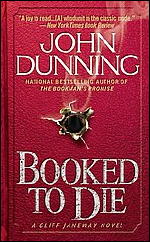
Two O’Clock, Eastern Wartime tells the story of Jack Dulaney, aka Jordan Ten Eyck, and Holly Carnahan. The two were in love years ago but drifted apart after the death of their friend and Jack’s rival, Tom Rooney. Now Jack wants to find Holly again, and with the help of an often-inebriated radio actor friend, Marty Kendall, he begins his trip across America to Pennsylvania, where Tom, Jack, and Holly all lived at one time and was Holly’s last known address.
But Jack encounters only suspicious characters and death along the way and, eventually, finds himself in Regina Beach, New Jersey at radio station, WHAR, looking for work and Holly’s father, Tom Carnahan. It is there that Jordan begins his career as a radio writer and with the WHAR radio community — Rue, Pauline and Hazel, radio actresses; Livia, a sound artist; and Waldo, creator of the magnificent black program, Freedom Road.
Woven into the story is Jordan’s journey into the discovery of the power of radio drama:

“Now he saw what he had was the rough draft of a half-hour radio play. He felt a surge of inexplicable excitement as he took the next logical step, prose into script in the middle of the page, and again his fingers were flying and all his new awareness was there in the words. He understood demands and restrictions that had never given him a conscious thought, and he saw the story anew. The opening could not linger. Leisure was fine for depth in prose but a story for the ear must begin with the first spoken word of the encounter that will drive it.”
Jordan discovers the power of radio and nothing, it seems, can hold back his thirst for creation as scripts and ideas continue to flood out of him. Later, he discovers that he can move beyond even that thirst by directing his own work. Dunning, through Jordan, makes the power of radio drama come alive.
All the thrill and excitement of the production both as listener as well as participant is explored. Meanwhile, Jordan becomes absorbed in the mystery of what became of Holly’s father, who disappeared from the radio station before their arrival and of one of the radio actor’s, March Flack, who disappeared in 1936. And what about the station’s seemingly ominous owner, Mr. Harford?
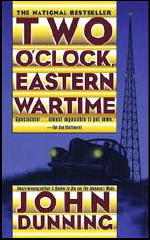
Jordan begins to write powerful and politically explosive scripts to the encouragement of the radio owner and management who hope to return the station to a glorious time before the war. His excitement begins to affect the actors and technicians as production reaches fever pitch.
“Jordan felt the play unfolding in his mind, the cotton fields stretching across most of the known world. He moved his hand: the sun went down. He raised a finger: the new day dawned in an explosion of sound, of horses and rowdies and the unmistakable din of a railroad yard. He stood like God and the universe rolled out at his feet. If he pointed left, Livia gave him London, a different kind of clatter with steel rims on cobblestones and a British flavor to the babble. He swept that away with a thrust of his arm, and in the cross fade sat Charity, three thousand miles away… He couldn’t remember a greater moment as it grew into the evening. This was it. Live radio.”
Surrounding this is Jordan the detective trying to find out what really happened at the station several years before. Using the power of his radio scripts, he attempts to seek out the truth from those who were there.
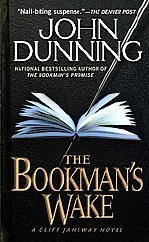
Jordan and Holly both become targets and become wrapped into the intrigue endangering them. The mystery of the German Schroeder boys, George and Peter, the attempts on his life, the mystery around the radio writer, Paul Kruger and his script about the Boer war all need answers for Jordan. The book is full of wonderful characters with stories to tell, who carry their own sense of mystery with them.
There are a number of writers who have written stories framed around early radio, but if you are both a fan of old time radio as well as a mystery thriller fan, then this book will definitely entertain.
John Dunning is a superb writer. As a mystery writer, he is new to this reviewer, but he is certainly an author I will seek out again.
Copyright 2001, 2010 by James F. Widner.
Editorial Comment: Jim Widner has long been involved with Old Time Radio, both as a collector and as a researcher, author and indexer. His web site is devoted to OTR in a historical context at Radio Days. For several years he has also produced a podcast called the Radio Detective Story Hour. Follow the links to each.
Sun 20 Jun 2010
IT IS PURELY MY OPINION
Reviews by L. J. Roberts
JIM BUTCHER – Changes. Roc, hardcover, April 2010; tall paperback: March 2011.
Genre: Paranormal mystery. Leading character: Harry Dresden, 12th in series. Setting: Chicago.
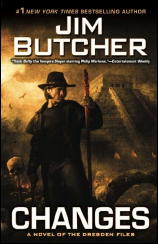
First Sentence: I answered the phone, and Susan Rodriguez said, “They’ve taken our daughter.”
Seven years ago, wizard Harry Dresden’s love, Susan Rodriguez left after being turned into a half-vampire. Now she calls to tell him that his daughter Maggie, about whom he’d never known, has been kidnapped by the Duchess of the Red Court.
Harry learns that Maggie is to be a blood sacrifice in an act that will destroy him and many others. Harry is determined to rescue his daughter.
I am, primarily, a mystery reader. I picked up Storm Front, the first Harry Dresden book by Jim Butcher thinking it would be interesting to see how he brings mysteries and the paranormal together.
While the books are far more paranormal/fantasy than mystery, about half-way into that first book, the genre definition no longer mattered. Harry Dresden is not the stuff of fairy tales — at least, not the Disney versions — Grimm was, after all, rather grim — but the stuff of nightmares with a wickedly good sense of humor.
It is definitely a series to be read in order. And, boy, does Butcher know how to tell a story. He touches every emotion while making us face the monsters in the closet. I thoroughly enjoy the references to movie, television, literature which have become part of our popular culture.
The world and characters created by Butcher are vividly drawn and often very unpleasant. Much of that is offset by the strong human characters, excellent dialogue and wonderful humor. There is a delightful bit where Harry says firmly, “I don’t do hats.” This is a jab to the fact that the cover of every book shows Harry wearing a hat.
Dresden is a classic hero. He is tall, attractive, strong, clever, protects the innocent and weak, destroys the bad buys and isn’t overly macho ever. As with each previous book, we continue to learn more of Dresden’s background. We also see the extent to which he is willing to go to protect and save others.
In Changes, Butcher brings together nearly all the characters of previous books for this pivotal story, and some wonderful characters they are. It’s thanks to his skill and imagination that we have Bob, the intelligent spirit who love trashy romance novels; Molly, Harry’s apprentice; Mouse, the amazing Foo dog; and all the others, human and inhuman.
The story is non-stop with some breath-catching moments, both in terms of pacing and suspense. It is touching, suspenseful, gruesome, emotional, violent and occasionally funny.
The book’s ending is as much a shock to us as it is to Harry. I’m one who usually abhors cliff-hanger ending, but then realized Butcher did play fair with us by the lead up to the ending. I am concerned about where the series is going from here, as I know the series is continuing. I’ll just have to trust to Butcher’s wonderful writing and go along for the adventure.
Rating: Very Good Plus.
Sat 19 Jun 2010
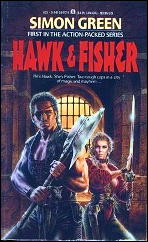
SIMON GREEN – Hawk and Fisher. Ace, paperback original; 1st printing, September 1990. Reprinted in Swords of Haven: The Adventures of Hawk & Fisher, an omnibus edition containing the first three books in the series; see below. Penguin/Roc, July 1999; trade ppbk, June 2006.
It is quite remarkable how you can come across the most interesting sorts of things when you least expect them. No one looking for the best locked room mystery written in 1990 (I wager to say) would ever in their right mind pick this book up to read — looking as it does as the latest variation of the Conan-based fantasy-action series that clog the science fiction shelves in every Waldenbooks store in the country.
Hawk and Fisher (male and female, and married to each other) are two captains of the guard in the dark city of Haven, on some unknown world at some unknown time, where magic works, and vampires, werewolves and succubi abound. (He has a patch over one eye, and she wears a shirt that exposes an ample amount of bosom, as well illustrated on the front cover.)
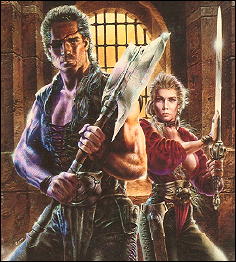
They are both tough, and even more remarkably, they are both honest, a rarity in Haven.
After disposing of a particularly bothersome vampire, they are asked to investigate the stabbing of an important reformist councilor in his locked bedroom. The crime could not have been committed by a magical spell, as first suspected, as the dead man wore an amulet about his neck designed especially to ward off such attacks.
Being a reformist in local politics means that the victim had many enemies, but the only ones who could have killed him are trapped in the house with him. Thus what this resembles, in perverse but strangely believable fashion, is an exceptionally good isolated county manor caper, complete with false trails, red herrings, and fine old-fashioned detective work.
The solution to the crime, reasonably intricate, is meticulously worked out as well. I can’t see any flaws in the story, which certainly triggered all the right responses in me. I don’t know how easy it will be for you to get your hands on a copy, but since several more in the series have appeared in the meantime, it’s possible Ace may have kept them all in print. Highly recommended.
— Reprinted from Mystery*File #35, November 1993.
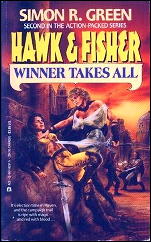
And from later on, from the same issue of Mystery*File:
SIMON GREEN – Winner Takes All. Ace, paperback original; 1st printing, January 1991.
The second in Green’s “Hawk & Fisher” series. The first, Hawk & Fisher, was an extremely pleasant surprise — a well-written locked room mystery taking place in a world of pure fantasy.
This new adventure of the two married members of the Guards is pure politics, however, as election time is nearing. Lots of swords, lots of evil sorcery, lots of action. Entertaining, but still a disappointment in not living up to expectations.
The Hawk & Fisher series:
Hawk & Fisher. Ace, September 1990.
Hawk & Fisher: Winner Takes All. Ace, January 1991.
Hawk & Fisher: The God Killer. Ace, June 1991.
Hawk & Fisher: Wolf in the Fold. Ace, September 1991
Hawk & Fisher: Guard Against Dishonor. Ace, December 1991.
Hawk & Fisher: The Bones of Haven. Ace, March 1992.
The six books were reprinted in two omnibus editions. The first is so mentioned above. The second grouping of three titles was entitled Guards of Haven, Penguin/Roc, ppbk, November 1999; trade ppbk, June 2007.
Editorial Comments: The artwork is so finely detailed it does not show up well in normal-sized images; hence the blow-up, as you see!
Also, George Kelley has just reviewed the two omnibus editions of Hawk & Fisher books on his blog. You can read his comments by following this link.
« Previous Page — Next Page »

